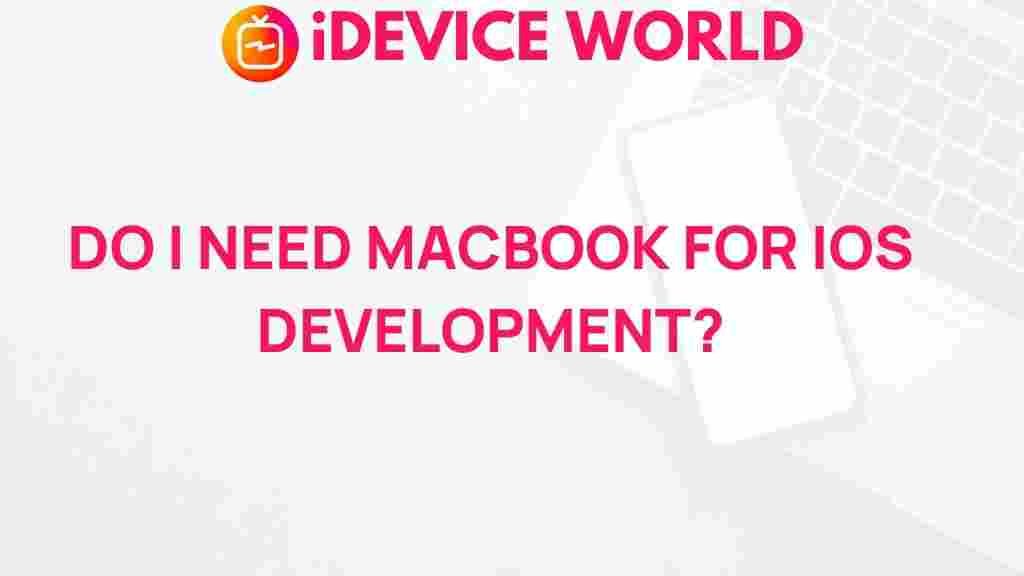iOS Development: Unleashing the Power of iOS Development on MacBook
In today’s fast-paced digital landscape, mobile applications play a vital role in enhancing user engagement and driving business success. Among the various platforms available, iOS development stands out as a key area for developers looking to create innovative and powerful applications. With a MacBook as your development environment, you can harness the full potential of iOS development. This article explores how to effectively leverage your MacBook for iOS development, covering everything from setting up your environment to troubleshooting common issues.
Why Choose MacBook for iOS Development?
The MacBook is often considered the gold standard for iOS development for several reasons:
- Optimized Performance: MacBooks are built with high-performance hardware that complements iOS development requirements.
- Exclusive Tools: Apple’s Xcode, the primary IDE for iOS development, is only available on macOS, making MacBooks essential for developing iOS applications.
- Seamless Integration: MacBooks offer excellent integration with other Apple devices, facilitating testing and deployment.
- User-Friendly Interface: macOS provides a clean and intuitive user interface, making it easier to focus on coding.
Setting Up Your MacBook for iOS Development
Before diving into iOS development, you need to ensure that your MacBook is properly set up. Follow these steps to create a robust development environment:
1. Install macOS
Ensure that your MacBook is running the latest version of macOS. Regular updates provide improved performance and security, essential for development.
2. Download Xcode
Xcode is the official integrated development environment (IDE) for iOS development. To install it:
- Open the App Store on your MacBook.
- Search for Xcode and click on the Get button.
- After installation, launch Xcode and agree to the license agreement.
3. Configure Xcode
Once Xcode is installed, configure it by following these steps:
- Open Xcode and create a new project.
- Select the iOS template for your application.
- Choose the appropriate project type (e.g., Single View App, Game, etc.).
4. Set Up a Developer Account
To test your applications on real devices and access advanced features, set up an Apple Developer account:
- Visit the Apple Developer website.
- Sign up for a developer account, which may involve a fee for access to certain resources.
The iOS Development Process
Now that your environment is set up, let’s explore the iOS development process step-by-step:
1. Planning Your App
Begin by defining your app’s purpose and target audience. Consider the features and functionality that will set your app apart in the crowded market. Create wireframes to visualize the user interface and user experience.
2. Coding the Application
Use Swift or Objective-C, the primary programming languages for iOS development. Swift is more popular due to its modern syntax and safety features. Here’s a basic structure of a Swift app:
import UIKitclass ViewController: UIViewController { override func viewDidLoad() { super.viewDidLoad() // Additional setup after loading the view }}3. Testing Your App
Testing is crucial to ensure that your app functions correctly and meets user expectations. Utilize the following methods:
- Simulator: Xcode includes an iOS simulator that allows you to test your app on various device configurations.
- Real Devices: Test your app on actual iOS devices to assess performance and usability.
- Beta Testing: Use platforms like TestFlight to distribute beta versions to real users for feedback.
4. Debugging Common Issues
While developing, you may encounter bugs and issues. Here are some tips for effective debugging:
- Use Xcode’s Debugger: Take advantage of Xcode’s built-in debugger to step through code and identify issues.
- Console Logs: Utilize print() statements to log information and track down errors.
- Read Error Messages: Pay close attention to error messages, as they often provide valuable insights into what went wrong.
5. Deployment
Once your app is polished and ready for launch, you can deploy it to the App Store:
- Ensure you have all the necessary assets, including app icons and screenshots.
- Prepare a compelling app description and promotional material.
- Submit your app through Xcode or App Store Connect for review.
Troubleshooting Common Issues in iOS Development
Even experienced developers face challenges during the development process. Here are some common issues and their solutions:
1. Xcode Crashes
If Xcode crashes frequently, try the following:
- Update Xcode to the latest version.
- Clear the derived data folder. Navigate to ~/Library/Developer/Xcode/DerivedData and delete the contents.
2. Build Failures
Build failures can be frustrating. To resolve them:
- Check for syntax errors in your code.
- Ensure all required frameworks are linked in your project settings.
- Clean the build folder by selecting Product > Clean Build Folder in Xcode.
3. App Not Launching on Device
If your app fails to launch on a real device:
- Ensure that your device is connected and trusted by your MacBook.
- Check the deployment target in your project settings to ensure compatibility with the device’s iOS version.
Conclusion
iOS development on a MacBook offers a unique and powerful environment for creating cutting-edge applications. By setting up your MacBook properly, following a structured development process, and troubleshooting effectively, you can unlock the full potential of iOS development. With determination and creativity, you can bring your app ideas to life and make a significant impact in the world of mobile technology.
For more insights into mobile app development, visit our resource page here. Happy coding!
This article is in the category Guides & Tutorials and created by iDeciveWorld Team
